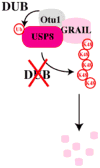GRAIL: a unique mediator of CD4 T-lymphocyte unresponsiveness
- PMID: 21078124
- PMCID: PMC3058357
- DOI: 10.1111/j.1742-4658.2010.07922.x
GRAIL: a unique mediator of CD4 T-lymphocyte unresponsiveness
Abstract
GRAIL (gene related to anergy in lymphocytes, also known as RNF128), an ubiquitin-protein ligase (E3), utilizes a unique single transmembrane protein with a split-function motif, and is an important gatekeeper of T-cell unresponsiveness. Although it may play a role in other CD4 T-cell functions including activation, survival and differentiation, GRAIL is most well characterized as a negative regulator of T-cell receptor responsiveness and cytokine production. Here, we review the recent literature on this remarkable E3 in the regulation of human and mouse CD4 T-cell unresponsiveness.
© 2010 The Authors Journal compilation © 2010 FEBS.
Figures



Similar articles
-
The transmembrane E3 ligase GRAIL ubiquitinates and degrades CD83 on CD4 T cells.J Immunol. 2009 Jul 1;183(1):438-44. doi: 10.4049/jimmunol.0900204. J Immunol. 2009. PMID: 19542455 Free PMC article.
-
E3 ubiquitin ligase GRAIL controls primary T cell activation and oral tolerance.Proc Natl Acad Sci U S A. 2009 Sep 29;106(39):16770-5. doi: 10.1073/pnas.0908957106. Epub 2009 Sep 17. Proc Natl Acad Sci U S A. 2009. PMID: 19805371 Free PMC article.
-
The gene related to anergy in lymphocytes, an E3 ubiquitin ligase, is necessary for anergy induction in CD4 T cells.J Immunol. 2004 Jul 1;173(1):79-85. doi: 10.4049/jimmunol.173.1.79. J Immunol. 2004. PMID: 15210761
-
Regulation of T helper cell differentiation by E3 ubiquitin ligases and deubiquitinating enzymes.Int Immunopharmacol. 2017 Jan;42:150-156. doi: 10.1016/j.intimp.2016.11.013. Epub 2016 Nov 30. Int Immunopharmacol. 2017. PMID: 27914308 Review.
-
The role of E3 ligases in autoimmunity and the regulation of autoreactive T cells.Curr Opin Immunol. 2007 Dec;19(6):665-73. doi: 10.1016/j.coi.2007.10.002. Epub 2007 Nov 26. Curr Opin Immunol. 2007. PMID: 18036806 Review.
Cited by
-
Potential of E3 Ubiquitin Ligases in Cancer Immunity: Opportunities and Challenges.Cells. 2021 Nov 25;10(12):3309. doi: 10.3390/cells10123309. Cells. 2021. PMID: 34943817 Free PMC article. Review.
-
Grail is involved in adipocyte differentiation and diet-induced obesity.Cell Death Dis. 2018 May 1;9(5):525. doi: 10.1038/s41419-018-0596-8. Cell Death Dis. 2018. PMID: 29743578 Free PMC article.
-
Ring finger protein 128 promotes, rather than inhibits, colorectal cancer progression by regulating the Hippo signaling pathway.Front Oncol. 2022 Dec 29;12:1031160. doi: 10.3389/fonc.2022.1031160. eCollection 2022. Front Oncol. 2022. PMID: 36644633 Free PMC article.
-
Mannose-Capped Lipoarabinomannan from Mycobacterium tuberculosis Induces CD4+ T Cell Anergy via GRAIL.J Immunol. 2016 Jan 15;196(2):691-702. doi: 10.4049/jimmunol.1500710. Epub 2015 Dec 14. J Immunol. 2016. PMID: 26667170 Free PMC article.
-
RNF149 negatively regulates LPS/TLR4 signal transduction by ubiquitination-mediated CD63 degradation.Heliyon. 2024 Jul 11;10(14):e34350. doi: 10.1016/j.heliyon.2024.e34350. eCollection 2024 Jul 30. Heliyon. 2024. PMID: 39104473 Free PMC article.
References
-
- Mueller DL. Mechanisms maintaining peripheral tolerance. Nat Immunol. 2010;11:21–27. - PubMed
-
- Schwartz RH. T cell anergy. Annu Rev Immunol. 2003;21:305–334. - PubMed
-
- Fathman CG, Lineberry NB. Molecular mechanisms of CD4+ T-cell anergy. Nat Rev Immunol. 2007;7:599–609. - PubMed
-
- Heissmeyer V, Macian F, Im SH, Varma R, Feske S, Venuprasad K, Gu H, Liu YC, Dustin ML, Rao A. Calcineurin imposes T cell unresponsiveness through targeted proteolysis of signaling proteins. Nat Immunol. 2004;5:255–265. - PubMed
-
- Macian F, Garcia-Cozar F, Im SH, Horton HF, Byrne MC, Rao A. Transcriptional mechanisms underlying lymphocyte tolerance. Cell. 2002;109:719–731. - PubMed
Publication types
MeSH terms
Substances
Grants and funding
LinkOut - more resources
Full Text Sources
Other Literature Sources
Research Materials

